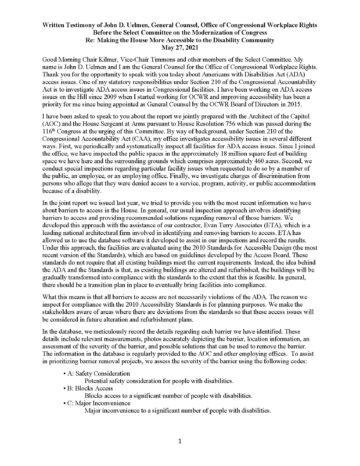Good Morning Chair Kilmer, Vice-Chair Timmons and other members of the Select Committee. My name is John D. Uelmen and I am the General Counsel for the Office of Congressional Workplace Rights. Thank you for the opportunity to speak with you today about Americans with Disabilities Act (ADA) access issues. One of my statutory responsibilities under Section 210 of the Congressional Accountability Act is to investigate ADA access issues in Congressional facilities. I have been working on ADA access issues on the Hill since 2009 when I started working for OCWR and improving accessibility has been a priority for me since being appointed as General Counsel by the OCWR Board of Directors in 2015.
I have been asked to speak to you about the report we jointly prepared with the Architect of the Capitol (AOC) and the House Sergeant at Arms pursuant to House Resolution 756 which was passed during the 116th Congress at the urging of this Committee. By way of background, under Section 210 of the Congressional Accountability Act (CAA), my office investigates accessibility issues in several different ways. First, we periodically and systematically inspect all facilities for ADA access issues. Since I joined the office, we have inspected the public spaces in the approximately 18 million square feet of building space we have here and the surrounding grounds which comprises approximately 460 acres. Second, we conduct special inspections regarding particular facility issues when requested to do so by a member of the public, an employee, or an employing office. Finally, we investigate charges of discrimination from persons who allege that they were denied access to a service, program, activity, or public accommodation because of a disability.
In the joint report we issued last year, we tried to provide you with the most recent information we have about barriers to access in the House. In general, our usual inspection approach involves identifying barriers to access and providing recommended solutions regarding removal of those barriers. We developed this approach with the assistance of our contractor, Evan Terry Associates (ETA), which is a leading national architectural firm involved in identifying and removing barriers to access. ETA has allowed us to use the database software it developed to assist in our inspections and record the results. Under this approach, the facilities are evaluated using the 2010 Standards for Accessible Design (the most recent version of the Standards), which are based on guidelines developed by the Access Board. These standards do not require that all existing buildings meet the current requirements. Instead, the idea behind the ADA and the Standards is that, as existing buildings are altered and refurbished, the buildings will be gradually transformed into compliance with the standards to the extent that this is feasible. In general, there should be a transition plan in place to eventually bring facilities into compliance.

